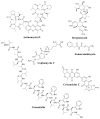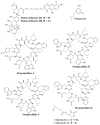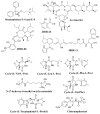Biodiversity of Secondary Metabolites Compounds Isolated from Phylum Actinobacteria and Its Therapeutic Applications
- PMID: 34361657
- PMCID: PMC8347454
- DOI: 10.3390/molecules26154504
Biodiversity of Secondary Metabolites Compounds Isolated from Phylum Actinobacteria and Its Therapeutic Applications
Abstract
The current review aims to summarise the biodiversity and biosynthesis of novel secondary metabolites compounds, of the phylum Actinobacteria and the diverse range of secondary metabolites produced that vary depending on its ecological environments they inhabit. Actinobacteria creates a wide range of bioactive substances that can be of great value to public health and the pharmaceutical industry. The literature analysis process for this review was conducted using the VOSviewer software tool to visualise the bibliometric networks of the most relevant databases from the Scopus database in the period between 2010 and 22 March 2021. Screening and exploring the available literature relating to the extreme environments and ecosystems that Actinobacteria inhabit aims to identify new strains of this major microorganism class, producing unique novel bioactive compounds. The knowledge gained from these studies is intended to encourage scientists in the natural product discovery field to identify and characterise novel strains containing various bioactive gene clusters with potential clinical applications. It is evident that Actinobacteria adapted to survive in extreme environments represent an important source of a wide range of bioactive compounds. Actinobacteria have a large number of secondary metabolite biosynthetic gene clusters. They can synthesise thousands of subordinate metabolites with different biological actions such as anti-bacterial, anti-parasitic, anti-fungal, anti-virus, anti-cancer and growth-promoting compounds. These are highly significant economically due to their potential applications in the food, nutrition and health industries and thus support our communities' well-being.
Keywords: Streptomyces; VOSviewer software; aquatic and marine environments; drug-resistant pathogens; microbial ecology; natural products.
Conflict of interest statement
The authors declare no conflict of interest.
Figures







References
-
- Ribeiro I., Girão M., Alexandrino D., Ribeiro T., Santos C., Pereira F., Mucha A., Urbatzka R., Leão P., Carvalho M. Diversity and Bioactive Potential of Actinobacteria Isolated from a Coastal Marine Sediment in Northern Portugal. Microorganisms. 2020;8:1691. doi: 10.3390/microorganisms8111691. - DOI - PMC - PubMed
Publication types
MeSH terms
Substances
LinkOut - more resources
Full Text Sources
Molecular Biology Databases

